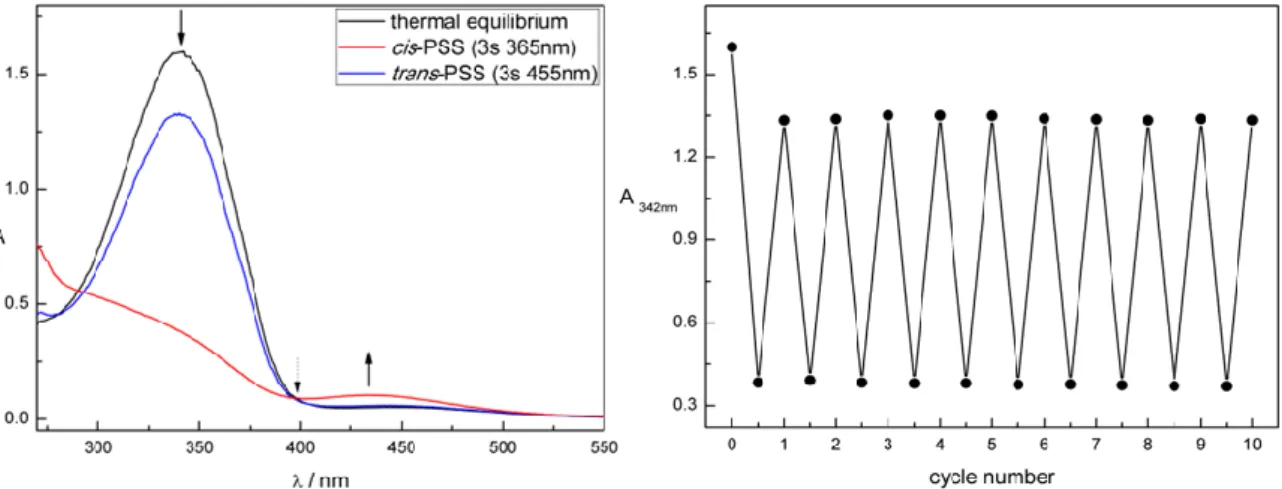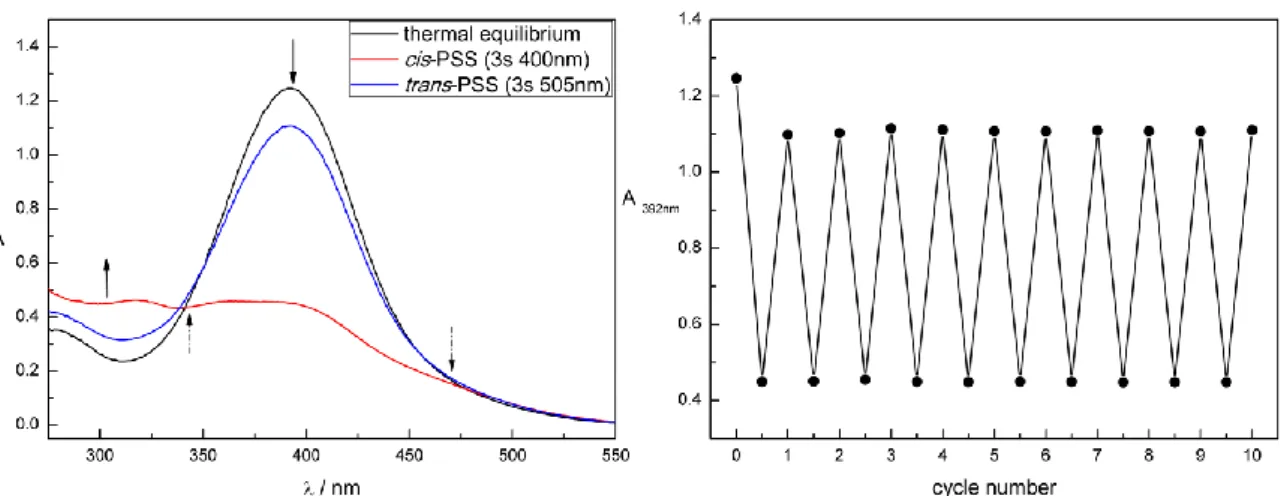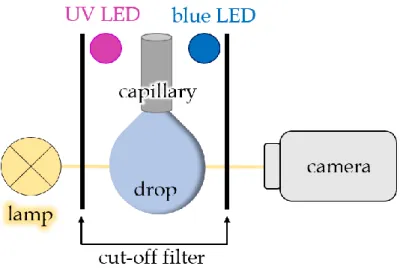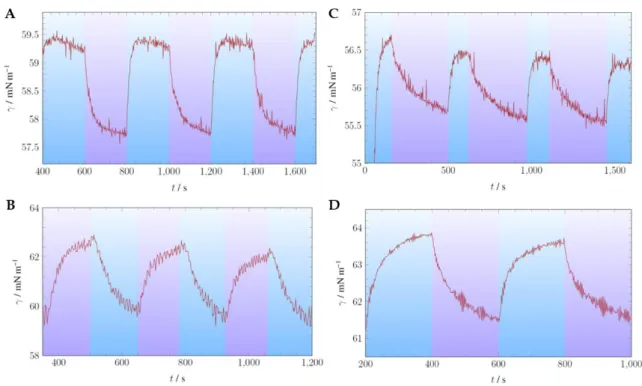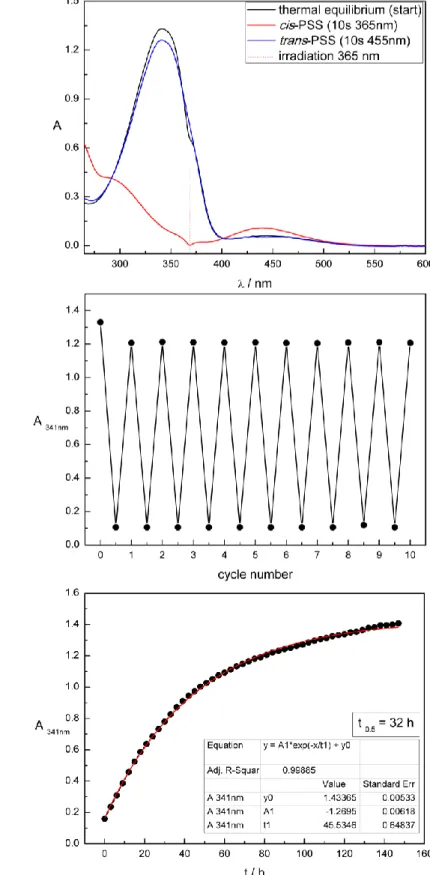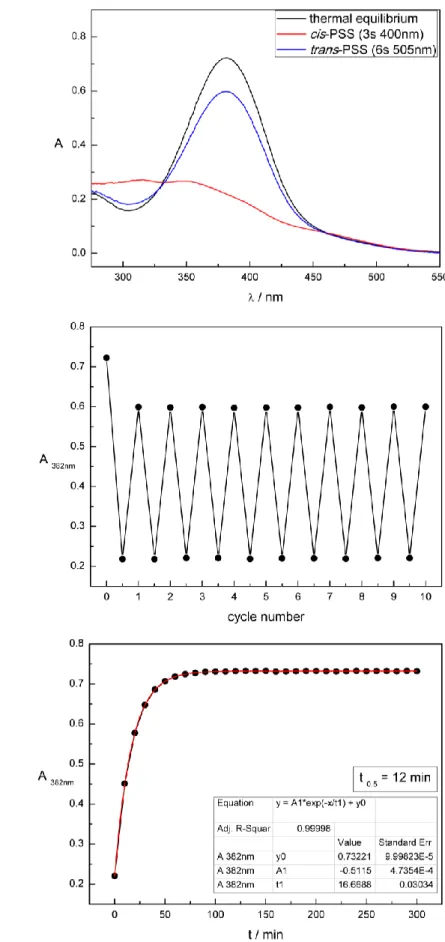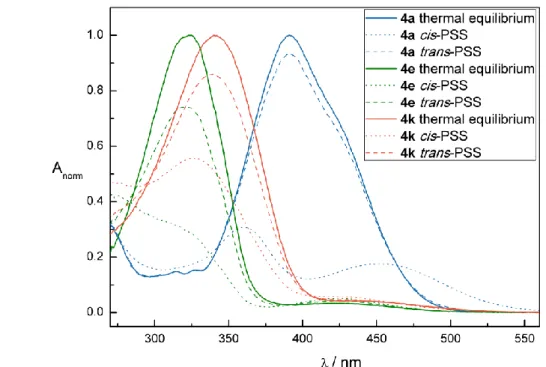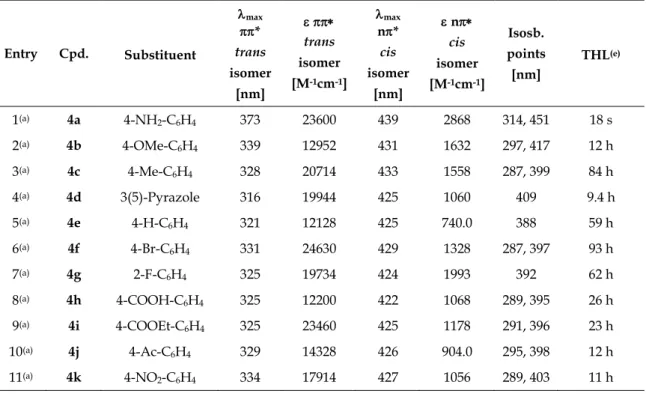Functionalized Photochromic Scaffolds
Dissertation
Zur Erlangung des Doktorgrades der Naturwissenschaften (Dr. rer. nat.)
an der Fakultät für Chemie und Pharmazie der Universität Regensburg
vorgelegt von
Karin Rustler
aus Regenstauf
2019
Der experimentelle Teil der vorliegenden Arbeit wurde in der Zeit von November 2016 bis Mai 2019 unter der Betreuung von Prof. Dr. Burkhard König am Institut für Organische Chemie der Universität Regensburg durchgeführt. Zusätzlicher Betreuer war von Juni 2019 bis August 2019 Prof. Dr. Itaru Hamachi am Department of Synthetic Chemistry and Biological Chemistry an der Graduate School of Engineering der Kyoto Universität, Japan.
Date of submission: 09.10.2019 Date of colloquium: 27.11.2019
Board of examiners: Prof. Dr. Julia Rehbein (chair) Prof. Dr. Burkhard König (1st referee) PD Dr. Hans-Heiner Gorris (2nd referee) Prof. Dr. Frank-Michael Matysik (examiner)
„Man merkt nie, was schon getan wurde, man sieht immer nur, was noch zu tun bleibt.“
- Marie Curie
T ABLE OF C ONTENTS
1PHOTOCHROMIC SURFACTANTS BASED ON AZOBENZENE ... 1
1.1 Introduction ... 3
1.2 Results and Discussion ... 4
1.2.1 Design and Syntheses ... 4
1.2.2 Photochemical Characterization ... 7
1.2.3 Drop Shape Analysis (DSA) ... 9
1.3 Conclusion ... 12
1.4 Experimental Part ... 12
1.4.1 General Procedures and Materials ... 12
1.4.2 Synthetic Procedures and Characterization ... 13
1.5 Supporting Information ... 18
1.5.1 1H- and 13C-NMR Spectra ... 18
1.5.2 UV-Vis Absorption Spectra, Cycle Performances, and Thermal Half-Lives... 27
1.6 References ... 33
2 PHOTOCHROMIC EVALUATION OF ARYLAZO NH-PYRAZOLES ... 37
2.1 Introduction ... 39
2.2 Results and Discussion ... 40
2.2.1 Design and Syntheses ... 40
2.2.2 Photochemical Characterization ... 42
2.3 Conclusion ... 46
2.4 Experimental Part ... 47
2.4.1 General Procedures and Materials ... 47
2.4.2 Synthetic Procedures and Characterization ... 48
2.4.3 Laser Flash Photolysis ... 51
2.5 Supporting Information ... 52
2.5.1 1H- and 13C-NMR Spectra ... 52
2.5.2 UV-Vis Absorption Spectra, Cycle Performances, and Thermal Half-Lives... 63
2.5.3 PSS Determination via NMR ... 107
2.6 References ... 118
3 DEVELOPMENT OF PHOTOSWITCHABLE INHIBITORS FOR -GALACTOSIDASE ... 123
3.1 Introduction ... 125
3.2 Results and Discussion ... 127
3.2.1 Design and Syntheses ... 127
3.2.2 Photochemical Characterization ... 130
3.2.3 Enzyme Inhibition ... 132
3.2.4 Docking Experiments ... 134
3.3 Conclusion ... 135
3.4 Experimental Part ... 135
3.4.1 General Procedures and Materials ... 135
3.4.2 Synthetic Procedures and Characterization ... 137
3.4.3 Enzymatic Inhibition Studies ... 147
3.4.4 Molecular Docking ... 148
3.5 Supporting Information ... 149
3.5.1 1H- and 13C-NMR Spectra ... 149
3.5.2 UV-Vis Absorption Spectra, Cycle Performances, and Thermal Half-Lives... 169
3.5.3 HPLC- and NMR-Based Photochromic Characterization ... 182
3.5.4 Enzymatic Inhibition ... 183
3.6 References ... 184
4 L -S A H H
4.2 Results and Discussion ... 193
4.2.1 Design and Syntheses ... 193
4.2.2 Photochemical Characterization ... 197
4.2.3 Studies on the Isolated Guinea Pig Ileum ... 199
4.3 Conclusion ... 201
4.4 Experimental Part ... 202
4.4.1 General Procedures and Materials ... 202
4.4.2 Synthetic Procedures and Characterization ... 203
4.4.3 Organ-Pharmacological Testing ... 208
4.5 Supporting Information ... 210
4.5.1 1H- and 13C-NMR Spectra ... 210
4.5.2 HSQC and HMBC spectra ... 223
4.5.3 UV-Vis Absorption Spectra and Cycle Performances ... 237
4.5.4 Thermal Half-Lives (THL) ... 241
4.5.5 Additional Photochemical Data ... 245
4.5.6 Analytical HPLC Traces for Purity Determination ... 246
4.5.7 Analytical HPLC Traces for PSS Determination ... 253
4.5.8 PSS Determination via NMR ... 255
4.5.9 Single Crystal X-ray Crystallography ... 259
4.5.10 Additional Pharmacological Data ... 267
4.5.11 Additional Chemical Structures ... 267
4.6 References ... 268
5 APHOTOCHROMIC GLYCINE POTENTIATOR AZOLOG ... 273
5.1 Introduction ... 275
5.2 Results and Discussion ... 277
5.2.1 Design and Syntheses ... 277
5.2.2 Photochemical Characterization ... 278
5.2.3 In Vivo Behavioral Studies ... 280
5.2.4 Molecular Docking ... 281
5.3 Conclusion ... 284
5.4 Experimental Part ... 284
5.4.1 General Procedures and Materials ... 284
5.4.2 Synthetic Procedures and Characterization ... 285
5.4.3 In Vivo Behavioral Studies ... 286
5.4.4 Molecular Docking ... 287
5.5 Supporting Information ... 289
5.5.1 1H- and 13C-NMR Spectra ... 289
5.5.2 UV-Vis Absorption Spectra and Cycle Performances ... 291
5.5.3 Thermal Half-Lives ... 292
5.5.4 Analytical HPLC Traces for Purity Determination ... 293
5.5.5 Analytical HPLC Traces for PSS Determination ... 295
5.5.6 PSS Determination via NMR ... 296
5.5.7 Single Crystal X-ray Crystallography ... 297
5.6 References ... 301
6 FULGAZEPAM: A FULGIMIDE-BASED POTENTIATOR OF GABAA RECEPTORS ... 305
6.1 Introduction ... 307
6.2 Results and Discussion ... 311
6.2.1 Syntheses ... 311
6.2.2 Photochemical Characterization ... 312
6.2.3 In Vitro Patch-Clamp Testing ... 314
6.2.4 In Vivo Behavioral Studies ... 315
6.3 Conclusion ... 317
6.4 Experimental Part ... 318
6.4.3 In Vitro Studies ... 321
6.4.4 Behavioral Studies ... 323
6.5 Supporting Information ... 325
6.5.1 1H- and 13C-NMR Spectra ... 325
6.5.2 UV-Vis Absorption Spectra and Cycle Performances ... 329
6.5.3 Analytical HPLC Traces for Purity Determination ... 331
6.5.4 Analytical HPLC Traces for PSS Determination ... 333
6.5.5 Single Crystal X-ray Crystallography ... 335
6.5.6 Additional in Vitro Patch-Clamp Data of Compound 3... 337
6.6 References ... 338
7 AZOLOGIZATION OF SEROTONIN 5-HT3RECEPTOR ANTAGONISTS 345 7.1 Introduction ... 347
7.2 Results and Discussion ... 349
7.2.1 Design and Syntheses ... 349
7.2.2 Photochemical Characterization ... 353
7.2.3 In Vitro Patch-Clamp Studies ... 355
7.3 Conclusion ... 356
7.4 Experimental Part ... 357
7.4.1 General Procedures and Materials ... 357
7.4.2 Synthetic Procedures and Characterization ... 358
7.4.3 In Vitro Studies ... 363
7.5 Supporting Information ... 365
7.5.1 1H- and 13C-NMR Spectra ... 365
7.5.2 UV-Vis Absorption Spectra, Cycle Performances, and Thermal Half-Lives... 375
7.5.3 Tabular Summarized Photochemical Data ... 385
7.5.4 Single Crystal X-ray Crystallography ... 386
7.6 References ... 390
8 PHOTOCHROMIC METAL COMPLEX-AGONIST CONJUGATES ... 397
8.1 Introduction ... 399
8.2 Results and Discussion ... 401
8.2.1 Design and Syntheses ... 401
8.2.2 Photochemical Characterization ... 405
8.2.3 In Vitro Fluorescence Ca2+ Imaging ... 407
8.3 Conclusion ... 409
8.4 Experimental Part ... 410
8.4.1 General Procedures and Materials ... 410
8.4.2 Synthetic Procedures and Characterization ... 411
8.4.3 In Vitro Studies ... 417
8.5 Supporting Information ... 419
8.5.1 1H- and 13C-NMR Spectra ... 419
8.5.2 UV-Vis Absorption Spectra, Cycle Performances, and Thermal Half-Lives... 429
8.5.3 In Vitro Fluorescence Ca2+ Imaging ... 431
8.6 References ... 434
9 SUMMARY ... 439
10 ZUSAMMENFASSUNG ... 445
11 APPENDIX ... 453
11.1 Abbreviations ... 453
11.2 Curriculum Vitae ... 458
12 DANKSAGUNG ... 463
1
C HAPTER 1
1 Photochromic Surfactants Based on Azobenzene
This chapter has not been published.
This project was performed in collaboration with A. Dietz (Prof. H. Motschmann, University of Regensburg). K. Rustler performed the synthesis and (photo-)chemical characterization of all compounds. A. Dietz performed the drop shape analysis. Mass spectrometry analysis were performed by the analytical department at the University of Regensburg. Prof. B. König and Prof.
H. Motschmann supervised the project.
CHAPTER 1
3
1.1 Introduction
The equilibrium of assembly and disruption of amphiphilic molecules into ordered structures such as monolayers, bilayers, vesicles and micelles is based on their divided character containing both a hydrophilic and a hydrophobic moiety in one molecule.[1] Besides their use for solubilization, emulsification, foaming, and detergency,[2] the dynamics of those clusters allow to control and manipulate motion of particles,[2-5] including reaction control via storage and release of reactants on demand.[6-11] Besides redox activity[12-15] and magnetic-field- sensitivity[16] as triggers for destabilizing responses, optical control via light allows modulation with high spatial and temporal resolution. Several classes of photoreactions interfering with organized structures of surfactants bearing a light- responsive hydrophilic/hydrophobic change are reported. So-called “destructible surfactants” undergo irreversible photoscission between their hydrophilic headgroups and hydrophobic tails. For reversible structural modulations, the most common tool is represented by a photoinduced cis-trans isomerization[1] of either an unsaturated double bond or an azobenzene within the hydrophobic chain of the surfactant.
Photochromic scaffolds, e.g., dithienylethenes (DTEs), fulgides, and the above mentioned azobenzenes have achieved increasing interest as small molecular devices enabling non-invasive, reversible light-control without any waste or side- products. Especially azobenzenes are frequently exploited for industrial and biomedicinal applications benefiting of their large change in sterics and polarity upon isomerization. In the case of azobenzene-based surfactants, the isomerization enhances either the hydrophobic character of the tail (trans isomer) or the hydrophilic character of the surfactant’s head group (cis isomer). Furthermore, the change in dipole moment and end-to-end distance leads to a variation in the organization of the surfactant molecules disrupting their arrangements.[17-19] It is reported that the addition of an azo moiety to the hydrophobic part of linear alkanesulfonates and -carboxylates promotes micellization.[20] In addition, it
PHOTOCHROMIC SURFACTANTS BASED ON AZOBENZENE
induces preassociation of surfactant monomers below the critical micellar concentration (cmc).[21] Furthermore, the cis-trans isomerization affects the surface tension of liquids resulting in changes up to 20 mN/m,[22,23] which can be determined using the hanging drop experiment.[24] A pendant drop is a small column of liquid provided at the end of a low diameter vertical tube and is defined by gravitation and surface tension. The latter one is related to the drop’s shape as described by the Young-Laplace equation.[25]
In the presented work, we envisioned that functionalizing amphiphilic molecules with an azobenzene as photochromic core between the polar head group and the hydrophobic chain could result in bursting of a hanging drop upon light-induced trans-cis isomerization and resulting change in organization of the molecules and overall surface tension. Hence, we synthesized and (photo-)chemically characterized differently substituted azo-surfactants, which were tested in cooperation with the group of Prof. Motschmann.
1.2 Results and Discussion
1.2.1 Design and Syntheses
Design. In a first attempt, alkane-azo-sulfonates and -carboxylates with different lengths of their hydrophobic tails are synthesized. To further increase the speed of the light-triggered trans-cis isomerization, push-pull azo-surfactants bearing an electron withdrawing nitro substitution as headgroup and a hydrophobic alkyl chain linked to the azo via an electron donating substituent are synthesized.
Synthesis of alkane-azo-carboxylates. The synthesis of differently substituted alkane-azo-carboxylates is based on a Baeyer[26]-Mills[27]-reaction of an aromatic nitroso and an arylamine (Scheme 1). In a first synthetic step, ethyl-4- aminobenzoate (1) is oxidized to its corresponding nitroso derivative 2 using potassium peroxymonosulfate as oxidant in a biphasic solvent mixture preventing
CHAPTER 1
5 Cleavage of the ester in basic media using potassium hydroxide provided the corresponding alkane-azo-carboxylates 7 (n = 5) and 8 (n = 11).[29] To increase both the solubility in aqueous media and the polarity of the head group, samples of the carboxylic acids 7 and 8 were converted into their sodium salts 9 (n = 5) and 10 (n = 11). As the corresponding carboxylic acids 7 and 8 are not deprotonated in water (pH = 7) due to their low pKa value (pKa of benzenecarboxylic acid = 4.2;[30]
pKa of azobenzene carboxylic acid = 3.8[31]), the sodium salts provide the presence of a charged species during the investigations.
Scheme 1. Synthesis of alkane-azo-carboxylates 7 (n = 5) and 8 (n = 11) and their corresponding sodium salts 9 (n = 5) and 10 (n = 11).[26-29]
Synthesis of alkane-azo-sulfonates. In a first approach, a Baeyer[26]-Mills[27]- reaction in analogy to Scheme 1 starting from benzene sulfonic acid was attempted for the synthesis of alkane-azo-sulfonates (Scheme 2). Sulfanilic acid (11) was converted into its tetrabutylammonium salt 12, which is soluble in organic solvents. Subsequent nitroso formation using oxone in a biphasic reaction mixture prevents overoxidation.[32] Due to low or no yields in the azo forming step, the synthetic strategy was changed. Byproducts are the overoxidized nitro-substituted
PHOTOCHROMIC SURFACTANTS BASED ON AZOBENZENE
sulfanilic acid as well as the symmetric azobenzene upon reaction of 13 with its precursor 12.
Scheme 2. Attempted synthesis of alkane-azo-sulfonates 15 (n = 5) and 16 (n = 8).[26,27,32]
In a second approach, commercially available aminoazobenzene sulfonic acid 17 was reacted with alkanoyl chlorides 18 (n = 5) and 19 (n = 8) to generate the alkanoyl amido azobenzene sulfonic acids 20 (n = 5) and 21 (n = 8) in high yields.
In contrast to the above mentioned carboxylic acid derivatives, the sulfonic acid derivatives 20 and 21 are completely deprotonated in water (pH = 7) bearing an overall negative charge (pKa of benzenesulfonic acid = 0.7)[32].
Scheme 3. Synthesis of the sulfonic acid substituted alkanamide azobenzene derivatives 20 and 21.
Synthesis of the push-pull derivatives. The synthesis of the push-pull azobenzenes 26 and 27 is based on a Baeyer[26]-Mills[27]-reaction. Para nitro aniline 22 was oxidized to its nitroso derivative and reacted with alkanoylether- 24 and alkanoyl amide-substituted aniline 25, respectively.
CHAPTER 1
7 Scheme 4. Synthesis of the push-pull azobenzene derivatives 26 and 27.[26,27]
1.2.2 Photochemical Characterization
The decision for one type of photochromic scaffold is strongly dependent on its application. In the case of amphiphiles, azobenzene as light-responsive moiety can easily be incorporated between the polar head group and the hydrophobic tail. In addition to their synthetic accessibility, azobenzenes undergo efficient light- induced photoisomerization without photodegradation, loss of responsiveness or photobleaching.[34,35]
The in general thermally more stable, planar trans isomer[35] (except bridged azobenzenes[36]) interconverts to its metastable, bent cis isomer upon irradiation with light of an appropriate wavelength resulting in a large change in geometry and dipole moment. Regeneration of the trans state occurs either quantitatively by thermal back relaxation or by irradiation with light only partially due to a substantial overlap of the absorption band of the trans and cis isomer.[35]
The photochemical properties of compounds 7, 8, 20, 21, 26, and 27 were investigated by UV-Vis spectroscopy in DMSO. Figure 1 shows exemplarily the UV-Vis absorption spectrum (left panel) and cycle performance (right panel) of alkane-azo-carboxylate 8 measured 50 µM in DMSO. The changes in absorption maxima upon irradiation are indicated with black arrows. Dotted black arrows label the isosbestic points indicating a clear two component switching without decomposition or side-reaction upon isomerization. The black curve represents the UV-Vis spectrum of compound 8 in its thermal equilibrium. Upon irradiation induced trans-cis isomerization using = 365 nm, the maximum around 350 nm
PHOTOCHROMIC SURFACTANTS BASED ON AZOBENZENE
decreased and a new maximum around 440 nm arised representing the compound in its cis-photostationary state (cis-PSS; red curve). Reisomerization is triggered by irradiation with visible light of = 455 nm (blue curve, trans-PSS). The performance of the repetitive cycle measurement shows excellent fatigue resistance. After ten cycles no signs of photodegradation were observed.
Figure 1. Compound 8 measured 50 µM in DMSO. Left: UV-Vis spectrum. Right: Repetitive cycle performance.
In comparison, the photochromic properties of the alkane-azo-sulfonates 20 and 21 (Table 1) show a slight shift in the absorption spectrum due to the stronger electron withdrawing character of the sulfonic acid moiety compared to the carboxylic acid moiety. This tendency is more pronounced for the push-pull derivatives 26 and 27. Figure 2 shows the UV-Vis spectrum (left panel) and cycle performance (right panel) of compound 27 measured 50 µM in DMSO. The trans absorption maximum is shifted to the visible range. Both isomerizations are triggered using visible light: blue light of = 400 nm triggers the trans to cis and green light of = 505 nm the cis to trans isomerization. Furthermore, a broadening and overlap of the trans absorption band with the cis absorption band can be observed. In addition, as reported for push-pull azobenzenes, the thermal half- lives of 26 and 27 are shorter compared to the alkane-azo-sulfonate and -carboxylate derivatives (Table 1).
CHAPTER 1
9 Figure 2. Compound 27 measured 50 µM in DMSO. Left: UV-Vis spectrum. Right: Repetitive cycle performance.
All synthesized compounds featured excellent photochromic properties. Table 1 summarizes the characteristic photochemical data (absorption maxima, isosbestic points, thermal half-lives) of compounds 7, 8, 20, 21, 26, and 27 measured 50 µM in DMSO.
Table 1. Summary of the characteristic photochemical data of compounds 7, 8, 20, 21, 26, and 27 measured 50 µM in DMSO.
Entry Compound max trans isomer [nm]
max cis isomer [nm]
Isosbestic points
[nm] THL(a)
1 7 341 439 292, 401 32 h
2 8 342 434 291, 397 26 h
3 20 367 443 316, 434 20 h
4 21 368 446 316, 433 24 h
5 26 382 - 332, 460 12 min
6 27 392 - 343, 464 18 min
(a) Determined by thermal relaxation of an irradiated sample (cis-PSS) in the dark at room temperature.
1.2.3 Drop Shape Analysis (DSA)
The change in the surface tension of a water drop containing a monolayer of the synthesized photochromic surfactant was measured in its trans and cis state using drop shape analysis (DSA) of a hanging drop. Due to insufficient solubility of compounds 20, 21, 26 and 27 the experiment could only be performed for carboxylic acids 7 and 8 and their sodium salts 9 and 10. Figure 3 depicts the
PHOTOCHROMIC SURFACTANTS BASED ON AZOBENZENE
experimental DSA setup. A camera and a lamp are used to record the changes in the drop’s shape. Cut-off filters are used to ensure, that no light of the lamp or the camera might induce isomerization of the azobenzene surfactants. Two LEDs are switched on alternately to accumulate a substantial amount of the desired isomer.
Using this method, changes in the surface tension of the hanging drop upon continuous irradiation can be analyzed.
Figure 3. Schematic drawing of the DSA setup.
Figure 4 shows the plots of the measurement of the surface tension of compounds 7 and 8, respectively 9 and 10, depending on the subphase. As the solubility of the compounds in aqueous media was very low, the compounds were dissolved in chloroform and filtered to generate a saturated solution. The chloroform solution of the compound was applied to a hanging drop of water (compounds 7 and 8) and 10 mM aqueous NaOH (compounds 9 and 10), respectively. Upon evaporation of chloroform, the measurement of the surface tension was started. Irradiation with blue light ( = 460 nm), triggering the cis to trans isomerization is labeled with a blue box. Irradiation with UV light ( = 365 nm) for trans to cis isomerization is highlighted with a purple box. The surface tension of the protonated carboxylic acid 7 (subphase water) is shown in the upper left panel A; its deprotonated form
CHAPTER 1
11 protonated compound 8 (subphase water) is shown in the upper right panel C; its deprotonated form 10 (subphase 10 mM NaOH) in the lower right panel D.
Figure 4. Measurement of the surface tension using drop shape analysis. (A) Compound 7.
Subphase water. (B) Compound 9. Subphase 10 mM aq. NaOH. (C) Compound 8. Subphase water.
(D) Compound 10. Subphase 10 mM aq. NaOH.
Table 2 summarizes the surface tension values for the trans isomers, the cis isomers and the change in surface tension upon isomerization. The change in surface tension is increasing upon use of 10 mM aqueous NaOH as subphase compared to water. This might be explained by a higher solubility of the compound upon deprotonation of the carboxylic acid. The packing of the molecules in the monolayer is tighter and results in a stronger disorganization of the molecules upon trans to cis isomerization and in a larger change of the surface tension. The changes in surface tension for the shorter alkyl chain (n = 5) are higher than for the longer alkyl chain (n = 11). This might also be explained by a higher solubility of the shorter linked compound and a tighter packing of the molecules in the monolayer. Interestingly, for compound 9 the surface tension of the cis isomer is higher than for the trans isomer whereas in all other cases the surface tension of the trans isomer is higher. An explanation might be, that the in general more soluble cis isomer, its shorter tail and the charged moiety allow for molecules of
PHOTOCHROMIC SURFACTANTS BASED ON AZOBENZENE
the interface to enter the subphase. Thus, more molecules are packed in the subphase resulting in an increase of the surface tension, whereas in all other cases the trans isomer allows for tighter packing of the molecules.
Table 2. Surface tension of both isomeric states of compounds 7-10 analyzed using DSA.
Entry Compound trans isomer [mN/m]
cis isomer [mN/m]
(trans-cis)
[mN/m] Subphase
1 7 59.5 57.7 +1.80 water
2 9 59.8 62.8 -3.00 10 mM aq. NaOH
3 8 56.5 55.6 +0.90 water
4 10 63.8 61.4 +2.40 10 mM aq. NaOH
1.3 Conclusion
In summary, we synthesized azobenzene derivatives equipped with a rather soluble, polar head group (carboxylic acid, sulfonic acid, nitro) in para position and a hydrophobic alkyl chain of different lengths in para’ position. The compounds were synthesized based on a Baeyer[26]-Mills[27]-reaction or functionalization of commercially available azobenzene precursors. In the used setup, only the carboxylic acid substituted derivatives were soluble enough to be tested using drop shape analysis. Changes in surface tension upon light-induced isomerization could be triggered but were not strong enough to cause bursting of the hanging drop. As the azobenzene moiety seems to enhance the hydrophobic character of the surfactant stronger than expected, the azobenzene moiety should be placed in the middle of an alkyl chain bearing a positively charged head group on one end to behave similar as non-photochromic alkane-substituted surfactants.
1.4 Experimental Part
1.4.1 General Procedures and Materials
Commercial reagents and starting materials were purchased from the commercial
CHAPTER 1
13 were used in p.a. quality and dried according to common procedures, if necessary.
Flash column chromatography was performed using Sigma Aldrich MN silica gel 60 M (40-63 µm, 230-400 mesh) for normal phase chromatography. Reaction monitoring via thin layer chromatography was performed on alumina plates coated with silica gel (Merck silica gel 60 F254, layer thickness 0.2 mm). Melting points were determined using a Stanford Research System OptiMelt MPA 100 and are uncorrected. NMR spectra were measured on a Bruker Avance 300 (1H 300.13 MHz, 13C 75.48 MHz), Bruker Avance III HD 400 (1H 400.13 MHz, 13C 100.61 MHz), Bruker Avance III HD 600 (1H 600.25 MHz, 13C 150.95 MHz) and Bruker Avance III 600 (1H 600.25 MHz, 13C 150.95 MHz). The spectra are referenced against the NMR solvent (DMSO-d6: H = 2.50 ppm, C = 39.52 ppm; CDCl3-d: H = 7.26 ppm, C = 77.16 ppm) and chemical shifts are reported in ppm. Resonance multiplicity is abbreviated as: s (singlet), d (doublet), t (triplet), q (quartet), p (pentet), and m (multiplet). Carbon NMR signals are assigned using DEPT 135 and
1H-13C HSQC spectra with (+) for primary/tertiary, (-) for secondary, and (q) for quaternary carbons. Mass spectra were recorded on a Finnigan MAT-SSQ 710 A, ThermoQuest Finnigan TSQ 7000, Agilent Q-TOF 6540 UHD, or a Jeol AccuTOF GCX instrument. UV-Vis absorption spectroscopy was performed in 10 mm quartz cuvettes using an Agilent 8543, Agilent Cary 100, or Agilent Varian Cary 50 spectrometer. Light sources for irradiation: = 365 nm (Seoul Viosys CUN6GB1A, 1000 mA, 1.4 W), = 400 nm (Luxeon 400 nm SZ-01-S2, 500 mA, 0.48 W), = 455 nm (Osram OSLON SSL 80 LD-CQ7P-1U3U, 1000 mA, 0.45 W), and = 505 nm (Osram OSLON SSL 80 LVCK7P-JYKZ, 800 mA, 163 lm). The power of the light is given based on the specifications supplied by the company when the LEDs were purchased.
1.4.2 Synthetic Procedures and Characterization
Ethyl (E)-4-((4-hexylphenyl)diazenyl)benzoate (5). Compound 5 was synthesized as orange solid in 86% yield (8.1 g, 24 mmol) using an adapted literature reported procedure[29] starting from hexylaniline 5 (5.0 g, 28 mmol, 1.0 eq) and nitroso
PHOTOCHROMIC SURFACTANTS BASED ON AZOBENZENE
benzoic acid ethyl ester 2[28] (5.0 g, 28 mmol, 1.0 eq). M.p.: 63 °C. 1H-NMR (300 MHz, CDCl3-d): δ = 8.24 – 8.15 (m, 2H), 7.98 – 7.84 (m, 4H), 7.38 – 7.28 (m, 2H), 4.41 (q, J = 7.1 Hz, 2H), 2.68 (t, 2H), 1.73 – 1.57 (m, 2H), 1.42 (t, J = 7.1 Hz, 3H), 1.36 – 1.24 (m, 5H), 0.98 – 0.81 (m, 3H). 13C-NMR (75 MHz, CDCl3-d): δ = 166.1 (q), 155.2 (q), 150.9 (q), 147.4 (q), 131.9 (q), 130.6 (+), 129.2 (+), 123.2 (+), 122.5 (+), 61.2 (-), 36.0 (-), 31.7 (-), 31.2 (-), 29.0 (-), 22.6 (-), 14.4 (+), 14.1 (+). HR-MS (ESI): calcd. for C21H27N2O2+ [M+H]+ 339.2067; found 339.2072. MF: C21H26N2O2. MW:
338.45 g/mol.
Ethyl (E)-4-((4-dodecylphenyl)diazenyl)benzoate (6). Compound 6 was synthesized as orange solid in 95% yield (1.5 g, 3.6 mmol) using an adapted literature reported procedure[29] starting from dodecylaniline 4 (1.0 g, 3.8 mmol, 1.0 eq) and nitroso benzoic acid ethyl ester 2[28] (0.70 g, 3.8 mmol, 1.0 eq). M.p.:
71 °C. 1H- NMR (400 MHz, CDCl3-d): δ = 8.19 (d, J = 8.7 Hz, 2H), 7.93 (d, J = 8.3 Hz, 2H), 7.87 (d, J = 8.2 Hz, 2H), 7.33 (d, J = 8.1 Hz, 2H), 4.42 (q, J = 7.1 Hz, 2H), 2.69 (t, J = 7.7 Hz, 2H), 1.66 (p, J = 7.3 Hz, 2H), 1.43 (t, J = 7.1 Hz, 3H), 1.35 – 1.19 (m, 18H), 0.88 (t, J = 6.6 Hz, 3H). 13C-NMR (101 MHz, CDCl3-d): δ = 166.1 (q), 155.3 (q), 150.9 (q), 147.5 (q), 131.9 (q), 130.6 (+), 129.2 (+), 123.2 (+), 122.5 (+), 61.2 (-), 36.0 (-), 31.9 (-), 31.3 (-), 29.7 (-), 29.7 (-), 29.7 (-), 29.6 (-), 29.5 (-), 29.4 (-), 29.3 (-), 22.7 (-), 14.4 (+), 14.1 (+). HR-MS (ESI): calcd. for C27H39N2O2+ [M+H]+ 423.3006; found 423.2997.
MF: C27H38N2O2. MW: 422.61 g/mol.
(E)-4-((4-hexylphenyl)diazenyl)benzoid acid (7). Compound 7 was synthesized as orange solid in 70% yield (2.6 g, 8.4 mmol) using an adapted literature reported procedure[29] starting from ethyl ester benzoic acid azobenzene 5 (4.2 g, 12 mmol, 1.0 eq) and KOH (38 g, 0.68 mol, 55 eq). M.p.: 228 °C. 1H-NMR (400 MHz, DMSO-d6): δ = 13.22 (s, 1H), 8.16 – 8.10 (m, 2H), 7.97 – 7.91 (m, 2H), 7.87 – 7.82 (m, 2H), 7.45 – 7.39 (m, 2H), 2.67 (t, J = 7.7 Hz, 2H), 1.60 (p, J = 7.5 Hz, 2H), 1.36 – 1.20 (m, 6H), 0.89 – 0.79 (m, 3H). 13C-NMR (101 MHz, DMSO-d6): δ = 167.2 (q), 154.8 (q), 150.7 (q), 147.8 (q), 133.1 (q), 131.1 (+), 129.9 (+), 123.4 (+), 122.9 (+), 35.5 (-), 31.5 (-),
CHAPTER 1
15 (E)-4-((4-dodecylphenyl)diazenyl)benzoid acid (8). Compound 8 was synthesized as orange solid in 82% yield (1.1 g, 2.9 mmol) using an adapted literature reported procedure[29] starting from ethyl ester benzoic acid azobenzene 6 (1.5 g, 3.5 mmol, 1.0 eq) and KOH (11 g, 0.20 mol, 55 eq). M.p.: 198 °C. 1H-NMR (400 MHz, DMSO-d6): δ = 13.23 (s, 1H), 8.16 – 8.10 (m, 2H), 7.97 – 7.91 (m, 2H), 7.89 – 7.83 (m, 2H), 7.47 – 7.40 (m, 2H), 2.72 – 2.64 (m, 2H), 1.62 (t, J = 7.4 Hz, 2H), 1.32 – 1.21 (m, 18H), 0.89 – 0.81 (m, 3H). 13C-NMR (151 MHz, DMSO-d6): δ = 166.5 (q), 154.8 (q), 150.7 (q), 147.9 (q), 133.2 (q), 131.1 (+), 129.9 (+), 123.4 (+), 122.9 (+), 35.5 (-), 31.8 (-), 31.1 (-), 29.5 (-), 29.5 (-), 29.5 (-), 29.4 (-), 29.3 (-), 29.2 (-), 29.1 (-), 22.6 (-), 14.4 (+). HR-MS (ESI): calcd. for C25H35N2O2+ [M+H]+ 395.2693; found: 395.2692.
MF: C25H34N2O2.MW: 394.56 g/mol.
(E)-4-((4-heptanamidophenyl)diazenyl)benzenesulfonic acid (20). Para amino para’ sulfonic acid azobenzene (17) (1.0 g, 3.6 mmol, 1.0 eq) was dissolved in pyridine (0.20 L) and heptanoyl chloride (18) (0.54 g, 3.6 mmol, 1.0 eq) was added dropwise. The reaction mixture was stirred at room temperature for 16 hours. The solvent was evaporated. Purification by recrystallization from methanol afforded the desired product (1.1 g, 2.9 mmol, 80%). M.p.: decomposition over 300 °C.
1H-NMR (400 MHz, DMSO-d6): δ = 10.24 (s, 1H), 7.91 – 7.85 (m, 2H), 7.85 – 7.72 (m, 6H), 2.36 (t, J = 7.4 Hz, 2H), 1.60 (p, J = 7.4, 6.6 Hz, 2H), 1.36 – 1.24 (m, 6H), 0.86 (t, 3H). 13C-NMR (101 MHz, DMSO-d6): δ = 172.3 (q), 152.2 (q), 150.8 (q), 147.8 (q), 143.0 (q), 127.1 (+), 124.2 (+), 122.3 (+), 119.6 (+), 37.0 (-), 31.5 (-), 28.8 (-), 25.4 (-), 22.5 (-), 14.4 (+). HR-MS (ESI): calcd. for C19H24N3O4S+ [M+H]+ 390.1482; found:
390.1487. MF: C19H23N3O4S. MW: 389.47 g/mol.
(E)-4-((4-decanamidophenyl)diazenyl)benzenesulfonic acid (21). Para amino para’ sulfonic acid azobenzene (17) (1.0 g, 3.6 mmol, 1.0 eq) was dissolved in pyridine (0.20 L) and decanoyl chloride (19) (0.69 g, 3.6 mmol, 1.0 eq) was added dropwise. The reaction mixture was stirred at room temperature for 16 hours.
Purification by recrystallization from methanol afforded the desired product (1.2 g, 2.7 mmol, 75%). M.p.: decomposition over 300 °C. 1H-NMR (400 MHz, DMSO-d6): δ = 10.24 (s, 1H), 7.91 – 7.77 (m, 8H), 2.35 (t, J = 7.4 Hz, 2H), 1.60 (t, J =
PHOTOCHROMIC SURFACTANTS BASED ON AZOBENZENE
7.2 Hz, 2H), 1.32 – 1.20 (m, 12H), 0.89 – 0.79 (m, 3H). 13C-NMR (101 MHz, DMSO-d6): δ = 172.3 (q), 152.2 (q), 150.7 (q), 147.8 (q), 143.1 (q), 127.2 (+), 124.2 (+), 122.3 (+), 119.6 (+), 37.0 (-), 31.7 (-), 29.4 (-), 29.3 (-), 29.2 (-), 29.1 (-), 25.5 (-), 22.6 (-), 14.4 (+). HR-MS (ESI): calcd. for C22H30N3O4S+ [M+H]+ 432.1952; found: 432.1955.
MF: C22H29N3O4S. MW: 431.55 g/mol.
(E)-1-(4-butoxyphenyl)-2-(4-nitrophenyl)diazene (26). Nitroaniline 22 (2.0 g, 14 mmol, 1.0 eq) was dissolved in CH2Cl2 (0.10 L) and stirred under a nitrogen atmosphere. Oxone (8.9 g, 14 mmol, 1.0 eq) was dissolved in water (0.10 L) and added to the solution. The biphasic reaction mixture was stirred at room temperature for three hours. The organic phase containing nitroso 23 was separated, dried, and used in the next step without further purification. A solution of butoxy aniline 24 (2.4 g, 14 mmol, 1.0 eq) in acetic acid (0.10 L) was added to the nitroso solution and the mixture stirred at room temperature for 16 hours. The product was purified by column chromatography using PE/EA 3/1 as eluent. The solvent was evaporated yielding 26 as orange solid in good yield (2.6 g, 8.7 mmol, 60%). M.p.: 115 °C. 1H-NMR (400 MHz, DMSO-d6): δ = 8.45 – 8.34 (m, 2H), 8.08 – 7.99 (m, 2H), 7.99 – 7.91 (m, 2H), 7.21 – 7.11 (m, 2H), 4.11 (t, J = 6.5 Hz, 2H), 1.73 (p, 2H), 1.45 (h, J = 7.4 Hz, 2H), 0.94 (t, J = 7.4 Hz, 3H). 13C-NMR (101 MHz, DMSO-d6):
δ = 163.1 (q), 155.9 (q), 148.5 (q), 146.6 (q), 125.9 (+), 125.5 (+), 123.6 (+), 115.7 (+), 68.4 (-), 31.1 (-), 19.2 (-), 14.2 (+). HR-MS (ESI): calcd. for C16H18N3O3+ [M+H]+ 300.1343; found: 300.1349. MF: C16H17N3O3. MW: 299.33 g/mol.
(E)-N-(4-((4-nitrophenyl)diazenyl)phenyl)pentanamide (27). Nitroaniline 22 (2.0 g, 14 mmol, 1.0 eq) was dissolved in CH2Cl2 (0.10 L) and stirred under a nitrogen atmosphere. Oxone (8.9 g, 14 mmol, 1.0 eq) was dissolved in water (0.10 L) and added. The biphasic reaction mixture was stirred at room temperature for three hours. The organic phase containing nitroso 23 was separated, dried, and used in the next step without further purification. A solution of pentanamide aniline 25 (2.8 g, 14 mmol, 1.0 eq) in acetic acid (0.10 L) was added to the nitroso
CHAPTER 1
17 was evaporated yielding 27 as orange solid in good yield (3.1 g, 9.4 mmol, 65%).
M.p.: 187 °C. 1H-NMR (400 MHz, DMSO-d6): δ = 10.33 (s, 1H), 8.46 – 8.37 (m, 2H), 8.11 – 7.99 (m, 2H), 7.99 – 7.89 (m, 2H), 7.89 – 7.80 (m, 2H), 2.38 (t, J = 7.5 Hz, 2H), 1.60 (p, J = 7.5 Hz, 2H), 1.34 (h, J = 7.3 Hz, 2H), 0.91 (t, J = 7.4 Hz, 3H). 13C-NMR (101 MHz, DMSO): δ = 172.5 (q), 155.8 (q), 148.5 (q), 147.8 (q), 144.2 (q), 125.5 (+), 125.0 (+), 123.7 (+), 119.6 (+), 36.8 (-), 27.6 (-), 22.3 (-), 14.2 (+). HR-MS (ESI): calcd.
for C17H19N4O3+ [M+H]+ 327.1452; found: 327.1458. MF: C17H18N4O3. MW:
326.36 g/mol.
PHOTOCHROMIC SURFACTANTS BASED ON AZOBENZENE
1.5 Supporting Information
1.5.1 1H- and 13C-NMR Spectra Compound 5 (CDCl3-d)
CHAPTER 1
19 Compound 6 (CDCl3-d)
PHOTOCHROMIC SURFACTANTS BASED ON AZOBENZENE Compound 7 (DMSO-d6)
CHAPTER 1
21 Compound 8 (DMSO-d6)
PHOTOCHROMIC SURFACTANTS BASED ON AZOBENZENE Compound 8 (DMSO-d6): HMBC spectrum
CHAPTER 1
23 Compound 20 (DMSO-d6)
PHOTOCHROMIC SURFACTANTS BASED ON AZOBENZENE Compound 21 (DMSO-d6)
CHAPTER 1
25 Compound 26 (DMSO-d6)
PHOTOCHROMIC SURFACTANTS BASED ON AZOBENZENE Compound 27 (DMSO-d6)
CHAPTER 1
27 1.5.2 UV-Vis Absorption Spectra, Cycle Performances, and Thermal Half-Lives
Figure S1. UV-Vis absorption spectroscopy of compound 7 measured 50 µM in DMSO. Upper panel: Absorption spectra (thermal equilibrium, cis-PSS, trans-PSS). Middle panel: Cycle performance. Lower panel: Thermal half-life.
PHOTOCHROMIC SURFACTANTS BASED ON AZOBENZENE
Figure S2. UV-Vis absorption spectroscopy of compound 8 measured 50 µM in DMSO. Upper
CHAPTER 1
29 Figure S3. UV-Vis absorption spectroscopy of compound 9 measured 50 µM in DMSO. Upper panel: Absorption spectra (thermal equilibrium, cis-PSS, trans-PSS). Middle panel: Cycle performance. Lower panel: Thermal half-life.
PHOTOCHROMIC SURFACTANTS BASED ON AZOBENZENE
CHAPTER 1
31
Figure S5. UV-Vis absorption spectroscopy of compound 26 measured 50 µM in DMSO. Upper panel: Absorption spectra (thermal equilibrium, cis-PSS, trans-PSS). Middle panel: Cycle performance. Lower panel: Thermal half-life.
PHOTOCHROMIC SURFACTANTS BASED ON AZOBENZENE
CHAPTER 1
33
1.6 References
[1] I. R. Dunkin, A. Gittinger, D. C. Sherrington, P. Whittaker, J. Chem. Soc., Perkin Trans. 1996, 2, 1837-1842.
[2] R. Lund, G. Brun, E. Chevallier, T. Narayanan, C. Tribet, Langmuir 2016, 32, 2539-2548.
[3] D. Yang, M. Piech, N. S. Bell, D. Gust, S. Vail, A. A. Garcia, J. Schneider, C.-D.
Park, M. A. Hayes, S. T. Picraux, Langmuir 2007, 23, 10864-10872.
[4] S. N. Varanakkottu, S. D. George, T. Baier, S. Hardt, M. Ewald, M. Biesalski, Lab Chip 2012, 12, 3637-3653.
[5] S. J. Ebbens, J. R. Howse, Soft Matter 2010, 6, 726-738.
[6] N. Drillaud, E. Banaszak-Léonard, I. Pezron, C. Len, J. Org. Chem. 2012, 77, 9553- 9561.
[7] T. Dwars, E. Paetzold, G. Oehme, Angew. Chem., Int. Ed. 2005, 44, 7174-7199.
[8] P. Cotanda, A. Lu, J. P. Patterson, N. Petzetakis, R. K. O’Reilly, Macromolecules 2012, 45, 2377-2384.
[9] E. Monflier, P. Bourdauducq, J.-L. Couturier, J. Kervennal, A. Mortreux, Appl.
Catal. A: Gen. 1995, 131, 167-178.
[10] E. Monflier, P. Bourdauducq, J.-L. Couturier, I. Suisse, J. Kervennal, A.
Mortreux, A. Catal. Lett. 1995, 34, 201-212.
[11] E. Monflier, P. Bourdauducq, J.-L. Couturier, J. Kervennal, E. Mortreux, J. Mol.
Catal. A: Chem. 1995, 97, 29-33.
[12] X. Liu, N. L. Abbott, J. Colloid Interface Sci. 2009, 339, 1-18.
[13] T. Saji, K. Hoshino, S. Aoyagui, J. Chem. Soc., Chem. Commun. 1985, 0, 865-866.
[14] S. Sakai, H. Takayanagi, N. Suminoto, S. Fukuzawa, T. Fujinami, H. Saeki, Appl. Organomet. Chem. 1990, 4, 35.
PHOTOCHROMIC SURFACTANTS BASED ON AZOBENZENE
[15] T. Saji, K. Ebata, K. Sugawara, S. Liu, K. Kobayashi, J. Am. Chem. Soc. 1994, 116, 6053-6054.
[16] P. Brown, A. M. Khan, J. P. K. Armstrong, A. W. Perriman, C. P. Butts, J. Eastoe, Adv. Mater. 2012, 24, 6244-6247.
[17] H. M. D. Bandara, S. C. Burdette, Chem. Soc. Rev. 2012, 41, 1809-1825.
[18] W. Szymański, J. M. Beierle, H. A. V. Kistemaker, W. A. Velema, B. L. Feringa, Chem. Rev. 2013, 113, 6114-6178.
[19] E. Merino, Chem. Soc. Rev. 2011, 40, 3835-3853.
[20] T. Koźlecki, A. Sokolowski, K. A. Wilk, Langmuir 1997, 13, 6889-6895.
[21] E. Chevallier, C. Monteux, F. Lequeux, C. Tribet, Langmuir 2012, 28, 2308-2312.
[22] T. G. Shang, K. A. Smith, T. A. Hatton, Langmuir 2003, 19, 10764-10773.
[23] B. A. Cicciarelli, J. A. Elia, T. A. Hatton, K. A. Smith, Langmuir 2007, 23, 8323- 8330.
[24] H. A. Ewart, K. E. Hyde, J. Chem. Educ. 1992, 69, 814-815.
[25] L. Sigalotti, F. Pena-Polo, L. Trujillo, Journal of Computational Methods in Sciences and Engineering 2012, 12, 371-382.
[26] A. Baeyer, Chem. Ber. 1874, 7, 1638-1640.
[27] C. J. Mills, J. Chem. Soc. 1895, 67, 925-933.
[28] A. D. Wong, T. M. Güngör, E. R. Gillies, ACS Macro Lett. 2014, 3, 1191-1195.
[29] R. Yamakado, M. Hara, S. Nagano, T. Seki, H. Maeda, Chem. Eur. J. 2017, 23, 9244-9248.
[30] W. N. Olmstead, Z. Margolin, F. G. Bordwell, J. Org. Chem. 1980, 45, 3295-3299.
[31] Calculated using Advanced Chemistry Development (ACD/Labs) Software
CHAPTER 1
35 [32] H. Kim, J. Gao, D. J. Burgess, Int. J. Pharm. 2009, 377, 105-111.
[33] B. Priewisch, K. Rück-Braun, J. Org. Chem. 2005, 70, 2350-2352.
[34] W. Szymański, J. M. Beierle, H. A. V. Kistemaker, W. A. Velema, B. L. Feringa, Chem. Rev. 2013, 113, 6114-6178.
[35] A. A. Beharry, G. A. Woolley, Chem. Soc. Rev. 2011, 40, 4422-4437.
[36] H. Sell, C. Näther, R. Herges, Beilstein J. Org. Chem. 2013, 9, 1-7.
37
C HAPTER 2
2 Photochromic Evaluation of Arylazo NH-Pyrazoles
This chapter has not been published.
This project was performed in collaboration with Dr. S. Crespi (Prof. B. L. Feringa, University of Groningen, Netherlands) and Dr. P. Nitschke (Prof. R. Gschwind, University of Regensburg).
K. Rustler performed the synthesis of all compounds besides 4e (synthesized by Dr. S. Crespi). K.
Rustler performed the (photo-)chemical characterization of the compounds except the thermal half- lives of compounds 4b, 4c, 4e, 4f, 4h, and 4j in DMSO, 4a, 4b, 4c, 4e-4h, 4j in DMSO:water, and 4a in methanol (performed by Dr. S. Crespi). Dr. P. Nitschke measured the photostationary states via NMR spectroscopy under constant irradiation. Dr. S. Crespi performed laser flash photolysis. Mass spectrometry analysis were performed by the analytical department at the University of Regensburg. Prof. B. König supervised the project.
CHAPTER 2
39
2.1 Introduction
Light is unsurpassed in nature as noninvasive, orthogonal, abundant fuel triggering diverse chemical and biological processes.[1,2] Recently, this spatiotemporal tool is exploited in the emerging field of photopharmacology.[3-8]
Irradiation with light induces a reversible isomerization between at least two states of a photochromic scaffold each characterized by a certain absorption spectrum and specific structural and electronical properties. Such photoswitches are used as small molecular tools allowing to control molecular properties, biological activity[9-10] or even motion as shown for molecular machines.[11] Amongst others, e.g., dithienylethenes and fulgides, azobenzenes are frequently reported for investigations in various scientific fields.[9,10,12-14] Depending on the required criteria for a specific application, efforts are made to control their thermal stability and the wavelengths triggering their isomerization. Azobenzenes are favored because of their synthetic accessibility, tuneability, and high fatigue resistance.
Besides, they show high extinction coefficients and quantum yields, allowing switching with low light intensity. Their thermodynamically stable, planar trans isomer can be converted to the metastable cis isomer by irradiation with light resulting in a huge change in geometry, end-to-end distance, solubility, and dipole moment. Regeneration of the usually thermally more stable trans isomer[9,10,12]
(except bridged azobenzenes)[15] can be achieved either by irradiation with light or by thermal relaxation. Due to a substantial overlap of the absorption bands of the trans and cis isomer of classical azobenzenes, a quantitative generation of one or the other isomer by irradiation is not feasible.[16] Depending on the substitution pattern, the thermal lifetime of the metastable cis isomer is strongly varying.[17] As a result of the increasing interest in finding a fitting azobenzene scaffold for each application with predictable optimized properties, more and more attention is paid to new azobenzene derivatives e.g., bearing heterocyclic rings as a substitute for the phenyl group.[18-23] This led to the discovery of arylazo pyrazoles (AAPs) benefiting of almost quantitative photoswitching in both directions (for dimethyl
